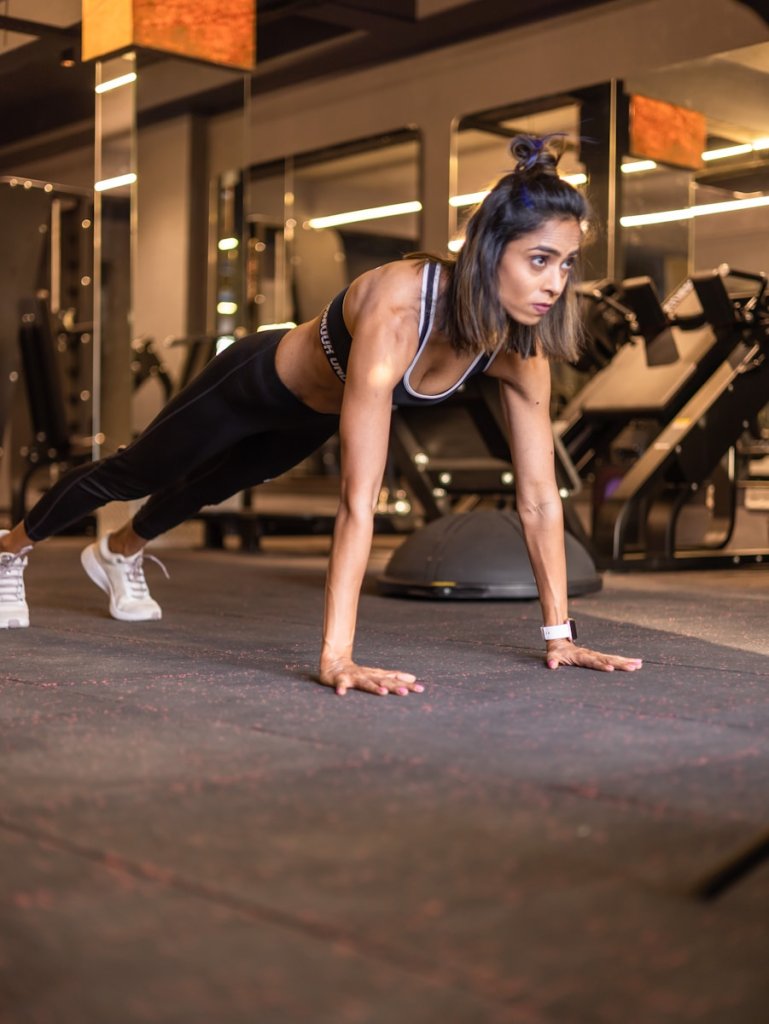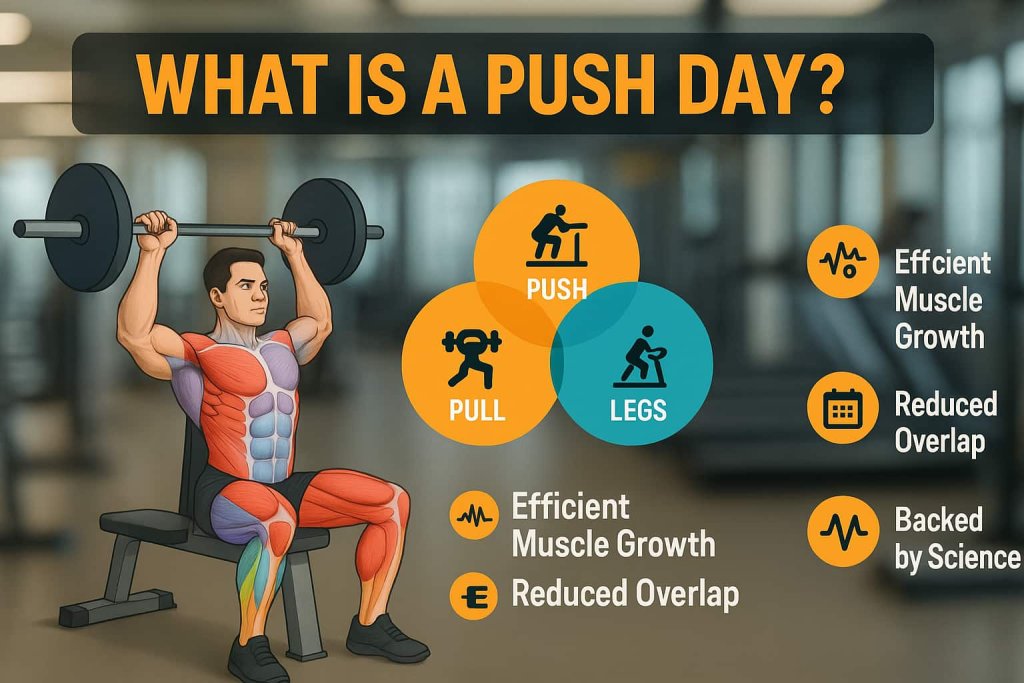The best push day workouts are those that target your chest, shoulders, and triceps with maximum effectiveness, using movements supported by science and recommended by top trainers. If you want to build upper-body muscle, boost pressing strength, and see real results, these 15 push exercises are the gold standard.

Understanding what makes a push day routine effective is crucial for anyone aiming to gain size, improve aesthetics, or train safely. With new research and expert programming, you can optimize your workout for both strength and muscle growth—no matter your experience level.
Below, you’ll find the key moves, variations, and why each exercise matters, so you can build your ultimate push day. These recommendations follow the latest fitness science and pro trainer advice.
What is a Push Day? (And Why It Works)
A “push day” is a workout dedicated to all the muscles involved in pushing movements—mainly the chest, shoulders (deltoids), and triceps. These muscles work together to perform any movement where you push weight away from your body, like bench presses or shoulder presses.

Benefits of Push Day Training
- Efficient Muscle Growth: Grouping push muscles together allows for focused fatigue and maximum muscle recruitment.
- Reduced Overlap: By splitting your week into push, pull, and legs, you prevent overtraining and give each muscle time to recover.
- Backed by Science: Studies using electromyography (EMG) consistently show that compound push exercises maximize upper body muscle activation (Jefit, 2024).
A typical “Push/Pull/Legs” split means you’ll train push muscles one day, pull (back/biceps) on another, and legs on a third, allowing for effective recovery and consistent strength gains.
The 15 Best Push Day Exercises (Science-Backed & Trainer Approved)
Push day exercises are all about targeting the chest, shoulders, and triceps—the major “pushing” muscles of the upper body. Building these muscle groups with compound and isolation movements is essential for total upper body strength, muscle mass, and balanced aesthetics. Below you’ll find detailed, actionable breakdowns for each exercise, updated with the latest evidence and pro tips.
1. Barbell Bench Press
Why It’s Essential:
The barbell bench press consistently ranks as the most effective chest builder by EMG studies, recruiting maximum muscle fibers in the pectorals, anterior deltoids, and triceps (Jefit, 2024).
How to Do It:
- Lie flat on a bench, grip bar slightly wider than shoulder-width.
- Pin shoulder blades back, feet flat on the floor.
- Lower the bar to mid-chest, elbows at about 75°.
- Drive through your heels to press the bar back up.
Trainer Tips:
- Maintain a controlled, steady tempo (2–3 seconds down, 1–2 up).
- Keep wrists straight and avoid excessive elbow flare.
- Use a spotter for safety with heavy loads.
Common Mistakes:
Flaring elbows too wide, bouncing the bar, letting hips rise.
Progressions:
Try tempo reps, paused bench, or add weight gradually.
Research:
MDPI EMG Study on Bench Press Variations (2024)
2. Dumbbell Bench Press
Why Use Dumbbells:
Dumbbells allow a greater range of motion and help correct left-right muscle imbalances. Research shows they can match barbells for chest activation while reducing joint strain (Garage Gym Reviews, 2024).
Variations:
- Flat, incline, or decline
- Neutral grip for less shoulder stress
Tips:
- Keep elbows at 45°, lower dumbbells slowly.
- Squeeze pecs at the top, don’t bang weights together.
Common Mistakes:
Using weights too heavy to control, drifting arms.
Pro Tip:
Include both dumbbell and barbell presses for optimal growth.
3. Incline Bench Press (Barbell or Dumbbell, 15–30°)
Science-Backed:
An incline of 15–30° best activates the upper (clavicular) chest without overloading the shoulders (MDPI, 2024).
Setup:
- Adjust bench to 15–30°.
- Keep feet planted and core tight.
- Press weights from upper chest level.
Tips:
- Chin tucked, avoid hyperextending lower back.
Why It’s Important:
Undertraining the upper chest leads to an unbalanced look.
4. Overhead Barbell Press (Standing)
Benefits:
This move is foundational for overall shoulder size and pressing strength. It recruits all deltoid heads and triceps, while challenging your core stability.
How To:
- Stand with bar at collarbone.
- Press overhead, elbows slightly forward.
Trainer Tips:
- Stand tall, avoid leaning back.
- Lock out fully overhead.
Mistakes:
Excessive arching, incomplete lockout.
5. Dumbbell Shoulder Press (Seated or Standing)
Why It’s Joint-Friendly:
The dumbbell press allows for a more natural movement path, making it easier on the shoulders and great for injury prevention.
Variations:
- Arnold press
- Alternating-arm
- Neutral grip
Tips:
- Lower to just below ear level.
- Press without letting weights touch at the top.
6. Push Press
What It Is:
A hybrid power move combining a slight knee dip with an explosive press, allowing for heavier loads and developing athletic power.
How To:
- Dip knees slightly.
- Drive bar overhead with force.
Tips:
- Keep dip quick and shallow, not a squat.
- Use as a progression before strict overhead presses.
7. Chest Fly (Dumbbell, Cable, or Machine)
Science:
Flys stretch and contract the chest in a way presses cannot, providing unique muscle activation.
How To:
- Keep slight bend in elbows.
- Open arms wide, squeeze chest at the top.
Mistakes:
Going too heavy, risking shoulder strain.
Variations:
Cable flys, pec-deck machine, lying dumbbell flys.
8. Cable Crossover / Pec-Deck
Why It Works:
Provides excellent inner and outer chest activation (EMG confirmed).
Tips:
- Use moderate weight, strict control.
- For lower chest, pull cables down; for upper, pull cables up.
Pro Tip:
Pause at peak contraction for 1–2 seconds.
9. Lateral Raise (Dumbbell or Cable)
Importance:
Builds “capped” shoulders by targeting the medial (side) deltoid, which pressing movements often miss.
How To:
- Raise dumbbells to just above shoulder level.
- Pinkies slightly higher than thumbs.
Cable Advantage:
Constant tension makes cables perfect for advanced lifters.
10. Arnold Press
Unique Feature:
Combines a shoulder press with a rotation for maximal front and side delt recruitment.
How To:
- Start palms facing you, rotate as you press overhead.
Tips:
- Smooth, controlled motion. Don’t rush rotation.
11. Close-Grip Bench Press
What It Does:
Moves more load to the triceps, with reduced shoulder strain. Ideal for arm size and strength.
How To:
- Hands just inside shoulder width.
- Elbows tucked close to body.
Mistakes:
Grip too narrow, wrists bending awkwardly.
12. Skull Crushers (Lying Triceps Extension)
Why It’s #1 for Triceps:
Directly targets the triceps long head—critical for upper-arm mass (StrengthLog, 2024).
How To:
- Lie on bench, arms vertical.
- Lower bar/dumbbells toward forehead, then extend.
Tips:
- Upper arms stay still; only forearms move.
13. Parallel Bar Dips (Chest-Focused Lean)
Bodyweight Staple:
Leaning forward targets the chest, upright emphasizes triceps.
How To:
- Grip bars, lean forward, lower until elbows ~90°.
Tips:
- Only go deep if you have healthy shoulders.
- Add weight with dip belt for progression.
14. Push-Up Variations
Versatile & Proven:
Push-ups can match bench presses for chest/triceps activation in advanced variations (EMG studies).
Top Variations:
- Standard
- Diamond (triceps)
- Pike (shoulders)
- Decline (upper chest)
Tips:
- Core tight, elbows 45°, full range of motion.
15. Machine Shoulder Press (Smith, Plate-Loaded, or Seated Machine)
Why Use Machines:
Safe for beginners, great for heavy loads without stability concerns.
How To:
- Set handles to shoulder height.
- Press upward, don’t let elbows drop too low.
Mistakes:
Half reps, setting seat too low.
How to Structure Your Push Day (Sample Routine)
- Warm-Up: 5–10 minutes dynamic stretches (shoulder circles, band pull-aparts).
- Main Compound Move: 1–2 compound presses (e.g., barbell bench, overhead press)
- Accessory Work: 1–2 dumbbell or machine presses, 1–2 isolation moves (flys, lateral raises)
- Triceps Finishers: Skull crushers, dips, or push-up variations
- Reps/Sets: 3–5 sets of 6–12 reps for compound lifts, 10–15 reps for isolation.
For maximum results, arrange your workout from biggest to smallest muscle groups:
Beginner/Intermediate Push Day Example:
- Barbell Bench Press – 3 x 6–8 reps
- Overhead Dumbbell Press – 3 x 8–10
- Incline Dumbbell Press – 3 x 8–12
- Lateral Raises – 3 x 12–15
- Chest Fly (Cable or Dumbbell) – 2 x 12–15
- Skull Crushers or Triceps Pushdowns – 2 x 10–12
- Dips or Push-Ups – 2 x max reps
Trainer Tips: Rest 1–2 min between sets. Warm up thoroughly with shoulder rotations and light sets. Focus on strict, full range of motion—quality > quantity.
Advanced Programming Tips
- Alternate Rep Ranges: Use heavy, low reps (4–6) for compound presses; higher reps (10–15) for isolation.
- Supersets: Pair chest and shoulder moves or triceps and chest for metabolic fatigue.
- Progressive Overload: Increase weight or reps every week for ongoing gains.
- Deload Weeks: Every 4–6 weeks, reduce volume to prevent overtraining.
Common Mistakes & How to Avoid Them
- Poor Form: Rushing reps or letting ego dictate weight can lead to injury.
- Neglecting Shoulder Health: Always balance pressing with pulling to protect your joints.
- Overdoing Volume: More is not always better. Quality sets and good recovery matter most.
Frequently Asked Questions
Q: Should I do all 15 exercises on one day?
A: No. Pick 5–7 exercises, covering chest, shoulders, and triceps. Rotate the others week-to-week for variety.
Q: How often should I do push day?
A: 1–2 times per week. Allow at least 48 hours before repeating to maximize growth.
Q: Are push-ups or dips better for triceps?
A: Both are effective. Dips allow more overload and chest activation, while diamond push-ups target the triceps more.
Q: Can I do push day at home?
A: Absolutely—use push-ups, chair dips, and any dumbbells or resistance bands you have.
Q: Do I need a spotter for barbell presses?
A: Yes, especially for heavy sets. For solo training, use dumbbells or a power rack with safety bars.
Conclusion
Science and expert trainers agree: the best push day workouts combine compound presses, strategic isolation moves, and careful programming for chest, shoulders, and triceps.
Stick with proven basics, train with great form, and challenge yourself to progress every week. You’ll see faster muscle growth, fewer injuries, and better performance.
